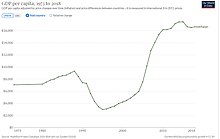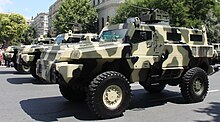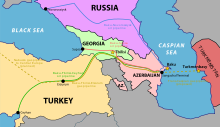|
Economy of Azerbaijan
The economy of Azerbaijan is highly dependent on oil and gas exports, in particular since the completion of the Baku-Tbilisi-Ceyhan Pipeline. The transition to oil production in the late 1990s led to rapid economic growth over the period 1995–2014.[18][19] Since 2014, GDP growth has slowed down substantially.[19] Large oil reserves are a major contributor to Azerbaijan's economy. Gas and oil make up two-thirds of Azerbaijan's GDP, making it one of the top ten most fossil fuel-dependent economies in the world.[20] Gas and oil make up 90% of Azerbaijan's export revenues and 60% of its finances.[21] Azerbaijan's economy is characterized by corruption and inequality.[18] The country's oil wealth has significantly strengthened the stability of Ilham Aliyev's regime and enriched ruling elites in Azerbaijan.[22][23][24][25] The country's oil wealth has enabled the state to host lavish international events, as well as engage in extensive lobbying efforts abroad.[26][27] The national currency is the Azerbaijani manat. The private sector is weak in Azerbaijan, as the economy is dominated by state-owned enterprises.[19] More than half of the formal labor force works for the government in Azerbaijan.[19] Economic history of AzerbaijanRepublic eraOil and gas are the most prominent products of Azerbaijan's economy. More than $60 billion was invested into Azerbaijan's oil by major international oil companies in AIOC consortium operated by BP. Oil production under the first of these PSAs, with the Azerbaijan International Operating Company, began in November 1997 and now is about 500,000 barrels per day. People visit petroleum spas (or "oil spas") to bathe in the local crude in Naftalan.[28] A leading caviar producer and exporter in the past, Azerbaijan's fishing industry today is concentrated on the dwindling stocks of sturgeon and beluga in the Caspian Sea. Azerbaijan shares all the problems of the former Soviet republics in making the transition from a command to a market economy, but its energy resources brighten its long-term prospects. Azerbaijan has begun making progress on economic reform, and old economic ties and structures are slowly being replaced. An obstacle to economic progress, including stepped up foreign investment, is the continuing conflict with Armenia over the Nagorno-Karabakh region.[29] In 1992, Azerbaijan became a member of the Economic Cooperation Organization.[30] In 2002, the Azerbaijani merchant marine had 54 ships.[31] In March 2001, Azerbaijan concluded a natural gas agreement with Turkey, providing a future export market for Azerbaijan. Azerbaijan has concluded 21 production-sharing agreements with various oil companies. An export pipeline that transports Caspian oil to the Mediterranean from Baku through Tbilisi, Georgia to Ceyhan, Turkey (the Baku-Tbilisi-Ceyhan Pipeline) became operational in 2006. The pipeline is expected to generate as much as $160 billion in revenues for the country over the next 30 years. The recent high price of oil is highly beneficial to Azerbaijan's economy, as the nation is in the midst of an oil boom. Eastern Caspian producers in Kazakhstan have also expressed interest in accessing this pipeline to transport a portion of their production. In 2010, Azerbaijan entered into the top eight biggest oil suppliers to EU countries with €9.46 billion.[32] In 2011, the amount of foreign investments in Azerbaijan was $20 billion, a 61% increase from 2010. According to Minister of Economic Development of Azerbaijan, Shahin Mustafayev, in 2011, "$15.7 billion was invested in the non-oil sector, while the rest – in the oil sector".[33]  In 2012, because of its economic performance after the Soviet breakup, Azerbaijan was predicted to become "Tiger of Caucasus".[34][35][36] In 2012, Globalization and World Cities Research Network study ranked Baku as a Gamma-level global city.[37] In 2015, Turkey and Azerbaijan agreed to boost mutual trade to US$15 billion by 2023.[38] Macroeconomic trend The following is a chart of trend of gross domestic product of Azerbaijan at market prices[39] with figures in USD.
For purchasing power parity comparisons, the US dollar was exchanged at 1,565.88 Manats only. Currently, the new Manat is in use, with an exchange rate of about 1 manat = $0.59. Mean graduate pay was $5.76 per man-hour in 2010. The following table shows the main economic indicators in 1980–2017.
Source: IMF[40] For more than a century the backbone of the Azerbaijani economy has been petroleum, which represented 50 percent of Azerbaijan's GDP in 2005, and is projected to double to almost 125 percent of GDP in 2007.[41] Now that Western oil companies are able to tap deep-water oilfields untouched by the Soviets because of poor technology, Azerbaijan is considered one of the most important areas in the world for oil exploration and development. Proven oil reserves in the Caspian Basin, which Azerbaijan shares with Russia, Kazakhstan, Iran, and Turkmenistan, are comparable in size to the North Sea, although exploration is still in the early stages. Sectors of the economyAgricultureAzerbaijan has the largest agricultural basin in the region. About 54.9 percent of Azerbaijan is agricultural lands. At the beginning of 2007 there were 4.76 million hectares (11.8 million acres) of utilized agricultural area.[42] In the same year, the total wood resources counted 136 million cubic metres (178 million cubic yards).[42] Azerbaijan's agricultural scientific research institutes are focused on meadows and pastures, horticulture and subtropical crops, leaf vegetables, viticulture and wine-making, cotton growing and medicinal plants.[43] In some lands, it is profitable to grow grain, potatoes, sugar beets, cotton and tobacco. Livestock, dairy products, and wine and spirits are also important farm products. The Caspian fishing industry is concentrated on the dwindling stocks of sturgeon and beluga. Some portions of most products that were previously imported from abroad have begun to be produced locally (among them are Coca-Cola by Coca-Cola Bottlers LTD, beer by Baki-Kastel, parquet by Nehir and oil pipes by EUPEC Pipe Coating Azerbaijan).[44] A new program which is prepared by the European Union is aimed to supporting the economic diversification of Azerbaijan.[45] Manufacturing In 2007, mining and hydrocarbon industries accounted for well over 95 percent of the Azerbaijani economy. Diversification of the economy into manufacturing industries remains a long-term issue.[46] As of the late 2000s, the defense industry of Azerbaijan has emerged as an autonomous entity with a growing defense production capability. The ministry is cooperating with the defense sectors of Ukraine, Belarus and Pakistan.[47] Along with other contracts, Azerbaijani defense industries and Turkish companies, Azerbaijan will produce 40 mm revolver grenade launchers, 107 mm and 122 mm MLRS systems, Cobra 4×4 vehicles and joint modernization of BTR vehicles in Baku.[48][49][50][51] Financial and business servicesThe banking sector remains small in relation to the size of the Azerbaijani economy. TelecommunicationsThe Azerbaijan telecommunications sector is embroiled in corruption. Azerbaijan President Ilham Aliyev and his family own two of Azerbaijan's largest mobile providers (Azerfon and Azercell) through offshore companies and potentially control three-quarters of the mobile market in Azerbaijan.[52] The third large mobile provider is Bakcell, which is registered as a company in an offshore tax haven and whose owners are unknown.[52] Ownership of the mobile providers in Azerbaijan enables the ruling Aliyev family to monitor phone calls and internet activity.[52] Investigative reporting revealed that Azerbaijani President Ilham Aliyev and his family made more than $1 billion when state shares of mobile operators were transferred to a purportedly "local partner" which was in reality owned by the Aliyev family's offshore companies.[53] Azerbaijan has relatively expensive call rates relative to comparable countries. The high prices are possibly due to consolidated control of the mobile market and a lack of competition.[52] The Azerbaijan government has stated that it wants to create a high-tech sector in Azerbaijan.[54] Tourism Tourism is an important part of the economy of Azerbaijan. The country was a well-known tourist spot in the 1980s. However, the fall of the Soviet Union, and the First Nagorno-Karabakh War during the 1988–1994 period, damaged the tourist industry and the image of Azerbaijan as a tourist destination.[55] It was not until the 2000s that the tourism industry began to recover, and the country has since experienced a high rate of growth in the number of tourist visits and overnight stays.[56] In recent years, Azerbaijan has also become a popular destination for religious, spa, and health care tourism.[57] During winter, the Shahdag Winter Complex offers skiing. The government of Azerbaijan has set the development of Azerbaijan as an elite tourist destination a top priority.[58] It is a national strategy to make tourism a major, if not the single largest, contributor to the Azerbaijani economy.[59] These activities are regulated by the State Tourism Agency and the Ministry of Culture. The Formula One Grand Prix is held in Baku, the capital city, and has been held here for years. Currency systemThe Azerbaijani manat is the currency of Azerbaijani, denominated as the manat, subdivided into 100 qapik. The manat is issued by the Central Bank of Azerbaijan, the monetary authority of Azerbaijan. The ISO 4217 abbreviation is AZN. The Latinised symbol is ( The manat is held in a floating exchange-rate system, managed primarily against the US dollar. The rate of exchange (Azerbaijani manat per US$1) for 28 January 2016, was AZN 1.60. There is a complex relationship between Azerbaijan's balance of trade, inflation, measured by the consumer price index and the value of its currency. Despite allowing the value of the manat to "float", Azerbaijan's central bank has decisive ability to control its value in relationship to other currencies. InfrastructureEnergy Two-thirds of Azerbaijan is rich in oil and natural gas.[60] The region of the Lesser Caucasus accounts for most of the country's gold, silver, iron, copper, titanium, chromium, manganese, cobalt, molybdenum, complex ore and antimony.[60] In September 1994, a 30-year contract was signed between the State Oil Company of Azerbaijan Republic (SOCAR) and 13 oil companies, among them Amoco, BP, ExxonMobil, Lukoil and Statoil.[61] As Western oil companies are able to tap deep-water oilfields untouched by the Soviet exploitation, Azerbaijan is considered one of the most important spots in the world for oil exploration and development.[62] Azeriqaz, a sub-company of SOCAR, intends to ensure full gasification of the country by 2021.[63] TransportationThe convenient location of Azerbaijan on the crossroad of major international traffic arteries, such as the Silk Road and the south–north corridor, highlights the strategic importance of the transportation sector for the country's economy.[64] The transport sector in the country includes roads, railways, aviation, and maritime transport. Azerbaijan is also an important economic hub in the transportation of raw materials. The Baku-Tbilisi-Ceyhan pipeline (BTC) became operational in May 2006 and extends more than 1,774 kilometers through the territories of Azerbaijan, Georgia and Turkey. The BTC is designed to transport up to 50 million tons of crude oil annually and carries oil from the Caspian Sea oilfields to global markets.[65] The South Caucasus Pipeline, also stretching through the territory of Azerbaijan, Georgia and Turkey, became operational at the end of 2006 and offers additional gas supplies to the European market from the Shah Deniz gas field. Shah Deniz is expected to produce up to 296 billion cubic meters of natural gas per year.[66] Azerbaijan also plays a major role in the EU-sponsored Silk Road Project. In 2012, the construction of Kars–Tbilisi–Baku railway expected to provide transportation between Asia and Europe through connecting the railways of China and Kazakhstan in the east with Turkey's Marmaray to the European railway system in the west. Broad gauge railways in 2010 stretched for 2,918 km (1,813 mi) and electrified railways numbered 1,278 km (794 mi). By 2010, there were 35 airports and one heliport.[4] RegulationSingle window system shares needed information through a single gateway with all organizations serving in trade field, as well as abolishes useless processes and raises the effectiveness of cooperation among different parties. 73 economies implement single window system in the world. Azerbaijan started to implement this system in 2009.[67] It implemented an E-Government portal as well.[68][69] A single-window system was established by a decree of the Azerbaijani President issued in 2007, 30 April, in order to simplify export-import procedures, innovate customs services, and improve the trade environment.[67] The president appointed the State Customs Committee as the leading body of controlling goods and transportation passing through the borders of the country in 2008.[70] The State Migration Service issues appropriate permits for foreigners and stateless persons coming to Azerbaijan to live and work. The "single window" principle has been applied on migration management processes starting from 1 July 2009 according to the Decree.[71] Poverty
As per the Asian Development Bank's estimates of 2017, 5.5% of the population of Azerbaijan lives below the poverty line in 2022.[72] In the same ADB report, it was estimated that for every 1000 babies born in Azerbaijan, 18 die before their 15th birthday.[72] Other economic indicators
17% of GDP (2011 est.)
1.1% (2012 est.)
-3% (2011 est.)
See also
References
Further reading
External links
|
|||||||||||||||||||||||||||||||||||||||||||||||||||||||||||||||||||||||||||||||||||||||||||||||||||||||||||||||||||||||||||||||||||||||||||||||||||||||||||||||||||||||||||||||||||||||||||||||||||||||||||||||||||||||||||||

